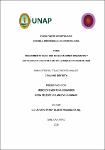Conocimiento en el uso de radiaciones ionizantes y actitudes en los dentistas de la ciudad de Iquitos, 2024

Date
2025Author
Montoya Benavides, Mercedes
Villanueva Ahuanari, Rosa Celeste
Metadata
Show full item recordAbstract
KNOWLEDGE IN THE USE OF IONIZING RADIATION AND ATTITUDES IN DENTISTS IN THE CITY OF IQUITOS, 2024. OBJECTIVE: To determine the relationship between knowledge on the use of ionizing radiation and the attitude of dentists in the city of Iquitos. METHOD: This was a quantitative, non-experimental, cross-sectional, correlational and prospective research. A sample of 234 dentists (male: 108, female: 126) from the city of Iquitos was used. Two questionnaires were used: one of knowledge and the other of attitude in the use of ionizing radiation. A correlation analysis was performed to determine the association between the two variables. RESULTS: In the bivariate analysis, of the dentists with a favorable attitude (87.2%), 43.6% (102 of 234) had adequate knowledge, 37.6% (88 of 234) had inadequate knowledge and 6% (14 of 234) had insufficient knowledge. On the other hand, of the dentists with an unfavorable attitude (12.8%), 0.9% showed adequate knowledge, 6% inadequate knowledge and 6% insufficient knowledge with the relationship being statistically significant (p = 0.001). CONCLUSIONS: A strong association was demonstrated between the knowledge and attitude of Iquitos dentists about the use of ionizing radiation. Future studies with longitudinal designs could help to elucidate the direction of the influence between these variables. CONOCIMIENTO EN EL USO DE RADIACIONES IONIZANTES Y ACTITUDES EN LOS DENTISTAS DE LA CIUDAD DE IQUITOS, 2024. OBJETIVO: Determinar la relación entre el conocimiento en el uso de radiaciones ionizantes y la actitud en los dentistas de la ciudad de Iquitos. MÉTODO: Esta investigación es cuantitativa, de diseño no experimental, transversal, correlacional y prospectivo. Se utilizó una muestra de 234 dentistas de la ciudad de Iquitos. Se empleó dos cuestionarios: uno de conocimiento y otro de actitud en el uso de radiaciones ionizantes. Se realizó un análisis de correlación para determinar la asociación entre ambas variables. RESULTADOS: En el análisis bivariado, los dentistas con una actitud favorable (87.2%), el 43,6% (102 de 234) tenía conocimientos adecuados, el 37.6% (88 de 234) conocimiento poco adecuado y el 6% (14 de 234) conocimiento insuficiente. Por otro lado, de los dentistas con una actitud poco favorable (12.8%), el 0.9% mostró un conocimiento adecuado, el 6% un conocimiento inadecuado y el 6% un conocimiento insuficiente siendo la relación estadísticamente significativa (p = 0,001). CONCLUSIONES: Se demostró una fuerte asociación entre el conocimiento y la actitud de los dentistas de Iquitos sobre el uso de radiaciones ionizantes. Estudios futuros con diseños longitudinales podrían ayudar a dilucidar la dirección de la influencia entre estas variables.
Collections
- Tesis [188]

